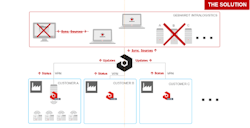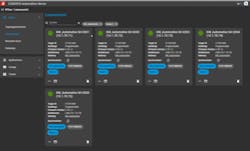How Do You Update 900 PLCs in Warehouses with Minimal Downtime?
The drive towards fully automated warehouses is stronger than ever before. Warehouse automation suppliers and industry consultants agree that a bigger spotlight has put on the use of automation in warehouses worldwide. LogisticsIQ’s latest post-pandemic market research study shows that the Warehouse Automation Market will reach the milestone of $30B by 2026, at an annual growth rate of about14% between 2020 and 2026.
DHL, a world-leading logistics company, reports that 80% of its warehouses are” still manually operated with no supporting automation”. Mechanized warehouses (those that use conveyors, sorters, goods-to-picker solutions, and other mechanized equipment, but not necessarily” automated”) account for only 15% of total warehouses, and only a tiny 5% are fully automated.
Right now, as the world is facing a pandemic that brings lots of uncertainty, companies have been forced to change their attitude towards warehouse automation from” nice to have” to “vitally important” to survive in the industry. Driven by demographic changes the warehouse automation supplier industry expects a double-digit growth in sales, driven by a growth in e-commerce and the advent of the Industrial Internet of Things, with increasing demand for data analytics and automated operations.
Existing fully automated warehouse systems can provide increased maximum output capacity while reducing logistics-related warehouse space used by up to 60%. Further, an automated system is much more resilient to environmental conditions than human workers - they can work in a refrigerated warehouse section all day long without getting cold feet. Using an efficient automated warehouse system means faster picking, faster packing, and faster shipping of orders.
One of the innovative players in the field of warehouse automation solutions is the Gebhardt Intralogistics Group. Gebhardt is the know-how leader in the field and delivers customized solutions in every area of internal material flow technology, internal transport, optimal storage and goods picking processes. Based in Germany and with subsidiaries in the United States, Poland and Austria Gebhardt is a global provider for versatile and modular solutions that allow optimal material flow in production and storage systems.
Decreasing update downtime using the Industrial Internet of Things
No matter if you are controlling warehouse logistic systems, special machines, mobile equipment or an automated industrial building, all these automation systems need one thing: updates of the control application to add new features, improve performance, adapt to changing requirements. Right now, this can be a time-consuming and costly process that can take the whole system offline. The following application of a CODESYS customer, the Gebhardt Intralogistics Group, shows how Digital Twins in the cloud and a cloud-based controller management can speed up the process of updating a large number of PLCs to the point where it’s just a few mouse clicks.
One of Gebhardt’s main products is a fully automated warehouse with a storage system that consist of long, parallel shelves with rails attached to each level of the shelves. Shuttles span the aisles and ride on the rails of the shelves forming the aisles. Since there are rails on all levels of the shelves, multiple shuttles can travel in each aisle at the same time and provide access to the stored goods.
To switch between levels, the ends of each aisle contain lifting devices that allow the shuttles to go up and down.
This design is very successful and Gebhardt already has 900 shuttles in service that are each controlled by their own CODESYS based PLC. Every now and then these 900 shuttles that usually run 24/7 need to be updated to the latest PLC code. In the good old days this was done by “sneaker-net” – walking up to every controller, plugging in a developer laptop, and updating the code. This process was awfully slow and cumbersome. Gebhardt used to have a system to roll out updates which was a little more advanced but still involved a lot of manual labor, took a long time, and since time is money in such systems, cost a lot of money.
The old approach
To be able to connect to the customers PLCs, the Gerhardt engineers set up virtual machines on the in-house server, one for each customer. This virtual machine (VM) was then connected to the customers warehouse network via a VPN. It allowed access to each PLC but no overview of the operating status of all shuttles. To find out what the status of each shuttle is and to update it, connecting to each shuttle individually was required. To commission all the shuttles in a new warehouse, a special tool was created.
To keep track of all the different versions of source code for the shuttles at different customer sites, a complex hierarchy of Windows folders was used.
With the continued success of Gebhardt’s solution and more and more storage systems being built, the number of installed shuttles quickly rose to 900. Support and updates became time-consuming, tedious and tasks were hard to coordinate with all the customers.
For each customer, such an update could drag on for hours. During that time, the entire aisle had to be shut down, and no orders for goods in that aisle could be processed. Obviously, customers were not very excited about updates. Finding a suitable window of an opportunity with the customer to perform updates was difficult. It also created a high pressure for Gebhardt’s technicians while conducting such updates. Overall, this update process can result in very critical situations, especially during an approximately one week-long commissioning phase during which the system is adapted to the customer's wishes.
The technician’s life often got stressful, even though they always tried to arrange downtimes outside of the customer's working hours.
Reducing update times from 120 minutes to just 20
While functional, Gebhardt’s home-grown way of doing updates wasn’t really what they wanted so they started to look for an alternative. One of the key points that an alternative would have to fulfil is to require little to no effort to maintain the required infrastructure. The solution that the Gebhardt Intralogistics Group selected and now utilizes, is the CODESYS Automation Server.
With the help of a few videos and the online documentation Gebhardt quickly found their way around in the CODESYS Automation Server’s online UI. They created their own “tenant” in the cloud server, a private area in which all their data is stored and managed. The tenant can be reached through a subdomain of automation-server.com and Gebhardt set it up with their own user management. They easily connected a couple of PLCs in their lab to the Automation Server and were able to send applications to all the connected controllers directly from the web UI, with just a few mouse clicks. As a bonus, the Automation Server automatically manages the source code for these applications as well as their revisions and deployment to the PLCs. This turned finding the right project file for any of the controllers from a lengthy file browsing and document process into a step as easy as clicking a single button.
After these promising lab experiments, the engineers took the next big step: they connected the PLCs in their own warehouse to the CODESYS Automation Server. After the required applications had been loaded to the server and the controllers were connected, they ran a test using the Automation Server to roll out the application software to all controllers. What used to take them 2 hours could now be done in a mere 20 minutes. The Automation Server shaved off nearly 85% of the time it takes to update, an increase in speed of 600%! In addition, NO engineer is required to be on site at the customer’s warehouse! The whole update process with the CODESYS Automation Server can be easily done online.
Digital twins of CODESYS PLCs
With the CODESYS Automation Server, Gebhardt can now roll out updates of their applications with little effort and also simplified their source code management significantly by letting the Automation Server handle it. Versioning and tracking which source code is running on which controller is easier and more transparent than ever.
The old method of an engineer manually managing project files in a complex folder hierarchy is now retired. Instead, the CODESYS Automation Server stores a copy of every version of the code that is ever deployed, remembers that this specific version is deployed on a specific controller (where it is deployed), and makes all this information readily available. The Gebhardt engineers evaluated using the Automation Server to manage the control network in their warehouse over a long trial period and analyzed in detail stability, uptime and data security.
In Gebhardt’s first new warehouse project at a customer site, a total of 15 controllers were connected to the CODESYS Automation Server and put into operation within half a day. In the Automation Server, each PLC’s Digital Twin has tags assigned indicating its location in the warehouse. This allows to structure the list of controllers within the Server and make it easy to find any particular controller.
Most recently, the cloud-based CODESYS Automation Server has even been adopted into brownfield projects. For example, Gebhardt now can conveniently manage 70 controllers and their PLC applications in a warehouse for a sporting fashion and, goods company, all remotely and without complex setup or configuration.
Gebhardt’s conclusion: “The CODESYS Automation Server saves us a considerable amount of time.”
CODESYS is the global market leader of manufacturer-independent IEC 61131-3-automation software with over 5 million device licenses sold worldwide. More than 500 control system manufacturers and tens of thousands of companies worldwide use CODESYS’ products. CODESYS is a software platform for industrial automation technology. The core of the platform is the IEC-61131-3 programming tool “CODESYS Development System”. It offers engineers practice-oriented, integrated solutions for the convenient configuration of automation applications. The goal is to provide users with practical support for their daily tasks.
Open interfaces, comprehensive security features, and a convenient connection to a cloud-based administration platform make CODESYS an ideal platform for Industry 4.0. Edge, fog, or cloud systems can be implemented using CODESYS. It makes Data exchange between devices in the Industrial Internet of Things (IIoT) easy.
Device manufacturers use CODESYS to create their own programmable or configurable automation components. To do that, they make the runtime system a part of their product. Using available product options, the functional scope of their device can be flexibly defined. The options include integrated products for visualization, coordinated motion control, and connection to fieldbus and Industrial Ethernet systems.
In North America, CODESYS is represented by the CODESYS Corporation, located on Boston’s North Shore. For information about CODESYS and about getting started with the CODESYS Automation Server, please contact:
Phone: +1-978-473-7600 E-Mail: [email protected] WEB Site: https://www.codesys.us/ WEB Store: us.store.codesys.com
Gebhardt Intralogistics Group:
The German GEBHARDT Intralogistics Group stands for material in motion and is constantly moving. Because the future of material flow systems is based on constant further development, the integration of new technologies, suitable processes, materials and components. In order to further develop internal logistics in all facets and to deliver customers optimum and ultimate systems every time and under every circumstance, GEBHARDT accumulates skills, creativity, energy, decades of experience, the latest technologies, precision and first-class materials. Efficiency and competitiveness are always at eye level with the market demands. The GEBHARDT Group has subsidiaries in the United States, Austria and Poland.




